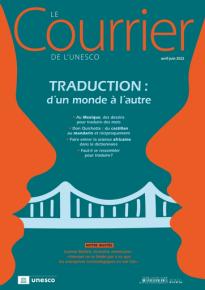فكرة
نفس جديد للإذاعة بفضل البودكاست

مع تطوير أشكال جديدة للسرد الصوتي، أعطى البودكاست أكثر من نفس جديد للإذاعة. ففي بضع سنوات فقط، غير مفهومها، وفي نفس الوقت مكنها من نسج علاقات وثيقة إلى حد كبير مع المستمعين.
بقلم سبحان ماك هوغ
تسمح الإذاعة بخلق مناخ حميمي مع المستمع، أكثر من أي وسيلة تواصل أخرى. وكان قد تفطّن إلى ذلك الرئيس الأمريكي فرانكلن د روزفلت منذ سنوات 1930، لما بعث عبر موجات الإذاعة برنامج «دردشات حذو المدفأة» (من 1933 إلى 1944). لكن ازدهار البودكاست منذ بضع سنوات أتاح تجديد العلاقة بين المذيع والمستمع.
تجديد هذه العلاقة نتج عن عاملين اثنين. فمن جهة، أصبح المتلقّي يستمع إلى البودكاست بمفرده، غالبا باستعمال سماعات الرأس أو السماعات الفردية، وهو ما يسمح بمخاطبة المستمعين «بالهمس في آذانهم». ومن جهة أخرى، المستمع هو الذي يختار بنفسه المادّة الإعلامية. وعلى عكس المذيع الذي يضطر إلى بذل كل الجهد ليُثني المستمع عن الانتقال إلى مادة أخرى، فإن منتج البودكاست مُتأكّد من أن المُتلقّي يرغب في الاستماع إليه، ممّا يسمح له بأن يكون هادئا وصادقا، كما يسمح لجمهوره بالتعاطف معه أكثر. إن اكتشاف بودكاست جديد أصبح لدى البعض شبيها بصداقة جديدة، وهو ما يُمثّل عددا هائلا من الأصدقاء بالنظر إلى الـ 700.000 بودكاست المتوفّرة في آيتونس التابعة للعملاق آبل، أكبر منصة في هذا القطاع.
تعود نشأة البودكاست إلى سنة 2004: آنذاك، كان الأمر يتمثّل فقط في ابتكار تكنولوجي يسمح للمحطات الإذاعية ببثّ برامجها بشكل غير مباشر. فكان بإمكانها نشر البودكاست على الإنترنت، وبإمكان المستَمعين تحميلها حسب ما يُناسبهم. ومصطلح «بودكاست» هو إدغام كلمتي «آيبود» (المشغل المحمول الذي اخترعته شركة آبل الأمريكية والذي يسمح للمستخدمين بتنزيل الملفات الصوتية) وبرودكاست (التي تعني «البث» باللغة الإنجليزية). وعبارة «بودكاست» التي اخترعها الصحفي بن هامرسلاي من صحيفة الغارديان، هي مصطلح يعكس هذه الخصائص.
طريقة غير مسبوقة لاستعمال سلطة الصوت
وكان لحصول تغيير تكنولوجي وآخر ثقافي وقع أساسي في ازدهار البودكاست. أولهما سنة 2012 لما قامت آبل بإدراج تطبيقة بودكاست أصلية في هاتفها الذكي تسمح بالوصول إلى البرامج المفضلة لدى المستمعين. وفي سنة 2014، أطلق فريق إذاعي أمريكي مستقل برنامج سيريال، وهو برنامج صحافة استقصائية عبر الإنترنت. ومنذ ذلك الحين، نقرة واحدة أصبحت كافية للاستماع إلى بودكاست، على جهاز محمول.
أما برنامج سيريال، فقد أمّن لمستمعيه سردا مذهلا لتحقيق مضادّ حول هاي مين لي، وهي تلميذة في التعليم الثانوي اغتيلت سنة 1999 في بلتيمور (الولايات المتحدة). وكان عدنان السيد، الصديق السابق للضحيّة، يقبع في السجن بعد أن حُكم عليه عام 2000 بالسجن المؤبد بتهمة القتل. ولكن، بالنسبة لسارة كونيغ منتجة البودكاست التي تحدثت طويلا مع السجين، لا زالت هناك شكوك تحوم حول إدانته. وكان المستمعون ينصتون طيلة الاثنتي عشرة حلقة إلى عرض دقيق للحجج.
وقد اكتشفت سارة كونيغ التي أحرزت على عديد الجوائز، طريقة جديدة لاستغلال سلطة الصوت. إن أسلوب سيريال لا يُشبه أي أسلوب سمعناه في الإذاعة إلى حد ذلك الحين. كانت سارة كونيغ تُخاطب مستمعيها وكأنهم رفاقها في رحلة البحث عن الحقيقة، وهو ما أثار نقاشات حيّة في الشبكات الاجتماعية. ومن ناحية أخرى، كانت الحلقات تتبع خطّا سرديّا طبيعيّا دون التقيد بجدول زمني، وكان طول الحلقة يتغيّر حسب الضرورة. وقد نال سيريال في الحين نجاحا كبيرا إذ سجّل خمسة ملايين تحميلا خلال الشهر الأول. ثمّ تبعه عدد لا يُحصى من البودكاست حول ملفات إجراميّة، وأحسنها، على غرار إن ذو دارك، تقدّم قصصا شيّقة بينت في بعض الأحيان أخطاء قضائية.
ومنذ ذلك الحين، تطوّر هذا الأسلوب في أشكال عديدة. وقد شهد بودكاست التحادث حيث يرتجل الضيوف تدخّلاتهم حول موضوع ما، انتشارا سريعا. ذلك أنه غير مُكلف، ولا يتطلب إلا انسجاما جيدا بين المتدخّلين وموضوعا يشد اهتمام المستمعين. البعض من هذا النوع من البودكاست موجه بالخصوص إلى النساء، مثل كول يور غيرلفراند وهو برنامج «موجه إلى أحسن الصديقات في كافة أرجاء الكرة الأرضيّة»، يكشف رؤية كل منهن للعالم، وكذلك البرنامج المشهور ستاف يو شود نوو الذي يقدم المعرفة كوسيلة للتسلية، حيث تتم استضافة رجال جذابين يتولون تثقيف المستمعين حول شتى المواضيع، من العلوم والتاريخ إلى الترياتلون وتقوية القدرات..
من بين الأشكال الأخرى المنتشرة، ذلك الذي يتولّى فيه الصحفيّون تشريح أحداث الأسبوع بنبرة غير رسمية متعمدة، ممّا يجعل المستمعين يشعرون بأنهم «أطراف فاعلة» صلب البودكاست. ونذكر في هذا المجال، على سبيل المثال، سلايت بوليتيكل غابفيست في الولايات المتحدة. وفي فرنسا، يتّبع لو نوفال أسبري بوبليك مقاربة مماثلة، إلا أن المتدخّلين هم من المُثقّفين، ويُدير النقاش فيليب مايار الصحفي المُتميّز الذي أنشأ هذا البودكاست بعد حذف برنامجه الإذاعي.
ثقافة شعبية، تفاهة وأحداث الساعة
وقد تكون المواضيع التي يتم تناولها تافهة. وما نلاحظه هو الانتشار المستمر لبرامج الثقافة الشعبية، على غرار آيز أون غيليد، وهو بودكاست أسترالي مُخصّص للمسلسل التلفزيوني الناجح أو هاندمايندز تايل. كما أن الحوارات تتكيف بشكل جيد مع البودكاست، وأحسن دليل على ذلك برنامج ذو جو روغان شو الذي يحظى بشعبية هائلة في البلدان الناطقة بالإنجليزية حيث يتحاور الممثل الهزلي الأمريكي مع المشاهير.
وسرعان ما أدركت الصحافة المكتوبة الفائدة من استغلال البودكاست للوصول إلى جمهور أوسع. وفي سنة 2017، أطلقت النيويورك تايمز برنامج ذو دايلي الذي «يروي الأحداث كما ينبغي». ويعتمد هذا البرنامج الذي يُقدمه الصحافي مايكل باربارو على صيغة بسيطة تتمثّل في اختيار حدث أو حدثين من أهم أحداث اليوم، والاستفادة من خبرة فريق النيويورك تاميز المتكون من 1300 صحفي لتقديم وجهة نظر مطّلعة، بنبرة غير رسمية وشخصية، وبالخصوص مصحوبة بإنتاج صوتي مُبتكر. فكانت النتائج فورية: اشترك الشباب بأعداد كبيرة (مجانًا)، وفي غضون سنتين، سجّل ذو دايلي مليوني تنزيل بالبودكاست. وفي سبتمبر 2019 ، اجتاز البرنامج عقبة مُذهلة بتحقيق مليار عملية تنزيل.
وإن كانت لحد الآن الولايات المتحدة والعالم الناطق باللغة الإنجليزية هم المسيطرين على سوق البودكاست، إلا أن الأمور تبدو في طور التغيّر. ففي مارس 2019، ذكرت شركة فوكسناست المختصّة في تقنيات الصوت، أن أهم تطوّر في عدد مستمعي البودكاست تم تسجيله في أمريكا اللاتينية، وخاصة في الشيلي والأرجنتين والبيرو والمكسيك. هذا المنحى نجد أثره في نجاح راديو أمبولانتي (الإذاعة المتنقّلة) وهي أكبر بودكاست للصحافة السردية باللغة الإسبانية في العالم (اطلع على مقال قِصص وطرائف من أمريكا اللاتينية على إذاعة أمبولانتي).
وفي نفس الوقت، شهد البودكاست تطوّرا حثيثا في الهند عبر شبكات البودكاست الكبيرة مثل إ. في. آم. بودكاستس. ويساهم الهنود المغتربون أيضًا في هذه الظاهرة ببرامج تتضمّن حوارات على غرار إنديا اكسبلايند. أما الشرق الأوسط فيعدّ حوالي 400 بودكاست، منها عيب، وهو بودكاست يُبثّ من عمّان (الأردن) ويهتمّ بالمواضيع الاجتماعية والثقافية والدينية التي عادة ما تُعتبر من المُحرّمات.
أما الصين فهي تميل إلى اعتماد نموذج مختلف للاستماع الإذاعي. ويتمثّل هذا النموذج في دفع مبلغ رمزي للاستماع إلى البرامج التربوية أو لمتابعة منصات صوتية تفاعلية مثل هيمالايا التي يشارك فيها 600 مليون مستخدم للغناء والحديث عن الأسرة والاستماع إلى الكتب الصوتية (اطلع على مقال في الصين، برامج حسب الطلب على هيمالايا أف. أم.). ونذكر كذلك غوشي أف. أم.، وهي تقليد لـ ذي أماريكن لايف تم إطلاقها مؤخرًا، التي تُعطي الكلمة لأشخاص يروون بالتفصيل قصصًا شخصية.
وبالفعل، يمكن أن يكون البودكاست أداة رائعة للإندماج. ويتطلب إنشاء بودكاست قادر على جلب اهتمام المستمعين، الإلمام بالجوانب العملية للإنتاج الصوتي ومعرفة طريقة عمل وسائل الاتصال السمعي. وبمجرد اكتساب هذه المعارف، يمكن لأي شخص تقريبًا إنشاء بودكاست، وهو ما يسمح للمجموعات المهمشة بتبليغ أصواتهم، مثل أعضاء الأقليات السياسية أو الدينية، أو مجموعات المثليين، والمعاقين، والمسنين، وما إلى ذلك.
وها أننا أصبحنا اليوم نُشاهد تجمعات ومنظمات غير حكومية ونشطاء ومؤسسات من مختلف الأنواع، تقوم بتطوير برامجها الخاصة، على غرار بودكاست مجلس السرطان الأسترالي الذي يُوفّر المعلومات والدعم، والمؤسسات الجامعية التي تعرض بحوثها في بودكاست، أو المحكمة العليا بفكتوريا (أستراليا) التي بعثت مبادرة اعتبرت «مبتكرة وثورية» جيرتيز لوو، تتمثل في بودكاست شعبي يتحدث فيه القضاة عن عملهم، بهدف جعل العدالة أكثر شفافية، وتقوية الثقة والاندماج الاجتماعي (اشتغلت كاتبة هذا المقال سبحان ماك هوغ كمنتجة-مستشارة في جيرتيز لوو).
في عالم يطغى عليه التضليل الإعلامي والحذر إزاء وسائل الإعلام، تُوفّر المصداقية التي يتّسم بها بثّ البودكاست فرصًا فريدة، بدءًا من الاستقصاء العميق إلى البحث عن العدالة الاجتماعية، مرورا بدعم الشفافية والثقة والاندماج الاجتماعي.
اطلع على مقالات أخرى نشرتها رسالة اليونسكو حول الإذاعة.
عرض لطريقة إنجاز بودكاست.
By Siobhan McHugh
More than any other means of communication, radio has the ability to create an atmosphere of intimacy with the listener. As early as in the 1930s, United States President Franklin D. Roosevelt harnessed this capability, delivering “fireside chats”, a series of evening radio addresses to the nation over the wireless (from 1933 to 1944). But in recent years, the growth of podcasting has dialled up radio’s incredible qualities to maximum volume.
There are two reasons for this. People usually listen privately, often through headphones, which allows hosts to speak to them directly into their ears. That sets up the perfect conditions for a host-listener bond. Unlike radio, where presenters are fighting the listener’s random switch-on and ability to change stations with the flick of a dial, the podcast host can trust that the listener wants to listen in. This allows hosts to relax and be authentic, which increases their relatability. Some listeners say finding a new favourite podcast is like making a new friend – with over 700,000 podcasts on US media giant Apple’s iTunes, the largest podcast platform, that’s a lot of friends.
Podcasting began simply enough in 2004 as a technological innovation, mostly used by radio stations to time-shift shows. They could be posted on the internet, to be downloaded at the listener’s convenience. The name podcast reflected that. Inadvertently coined by British technology journalist and broadcaster Ben Hammersley, it was an amalgam of the words iPod (the portable device created by Apple that allows users to download audio files) and broadcast.
Leveraging the power of the voice
Two developments – one technological, the other, cultural – helped transform the podcast market into a global industry. In 2012, Apple embedded a podcast app in its smartphones, which provided a library system that proved popular with listeners. A seismic cultural shift that introduced millions to the podcast format occurred in 2014, when an independent New York-based radio team packaged Serial, a podcast of online investigative journalism as gripping episodic narrative.
Serial’s first season offered a true story that grabbed its audience and hooked them onto the weekly podcast format. It told the story of Adnan Syed, who was convicted for the murder of his ex-girlfriend and high school classmate, Hae Min Lee, in Baltimore, US, in 1999. Syed was found guilty by a Baltimore County jury in 2000, when he was 18, and continues to serve a life sentence.
But the podcast host, Sarah Koenig, who interviewed him extensively over a prison payphone for the show, raised doubts about his conviction. Over twelve episodes, Koenig painstakingly combed through the evidence, interviewing many of those who were associated with the case.
Koenig – who received numerous awards, including the first-ever Peabody Award for a podcast – had stumbled onto a new way of leveraging the power of voice. Although grounded in regular audio journalism, Serial’s style was unlike anything heard on radio before. Firstly, she spoke to listeners as if they were companions in her quest for the truth, spawning lively debates on social media networks. Serial became an instant hit, clocking up five million downloads in the first month.
Serial’s popularity triggered a podcasting boom as media organizations scrambled to emulate its success. Countless true crime podcasts followed. The best, such as In The Dark, delivered engaging crafted storytelling, and sometimes exposed miscarriages of justice.
Pop culture, frivolity, and the news
Since then, the podcast genre has grown, taking on multiple formats. The chatcast genre, in which hosts make short, incisive comments on a theme, gained popularity. Inexpensive to make, the genre just needs a host with a good audience rapport and a distinctive theme that will attract listeners. There are chatcasts for women, such as Call Your Girlfriend, a frank and often funny show “for long-distance besties everywhere”. And the successful ‘knowledge as entertainment’ show, Stuff You Should Know, where the engaging male hosts seek to educate listeners about everything from science and history to triathlons and wills.
One common format has journalists breaking down the news of the week, but in a deliberately casual way. Listeners are made to feel like insiders on shows such as the online magazine Slate’s Political Gabfest in the US. In France, Le Nouvel Esprit Public has a similar approach, but its guests are public intellectuals moderated by veteran journalist Philippe Meyer – who started the podcast after his radio show was terminated.
Pop culture podcasts have proliferated, such as Eyes on Gilead, an Australian podcast about the hit television show, A Handmaid’s Tale. Interview shows also translate well to podcasting: a hugely popular example is The Joe Rogan Show, in which the American comedian interviews a raft of celebrities.
The press was quick to notice the potential of podcasting to extend its reach. In 2017, The New York Times launched The Daily, a narrative news digest billed as “How the news should sound”. Hosted by the Times political journalist Michael Barbaro, its formula is simple. Choosing one or two big stories of the day, it mines the expertise of the newspaper's 1,300 journalists to deliver an informed take on the news. The style of the podcast is casual and personalized, coupled with creative audio production.
The results were immediate: young people subscribed to the free podcast in droves. In two years, The Daily was getting two million downloads per show. In September 2019, it reached a new milestone: an astonishing one billion downloads overall.
Although the US and the English-speaking world have dominated the podcasting market in the last five years, that looks set to change. In March 2019, Voxnest, an audio technology company, reported that the highest growth in podcast listeners was in Latin America – particularly in Chile, Argentina, Peru and Mexico.
This is mirrored by the success of Radio Ambulante (see p.10), the biggest Spanish-language narrative journalism podcast in the world. It also produces an English-language version, hosted on NPR (National Public Radio) in the US.
In India, podcasting is expanding rapidly, via networks such as IVM Podcasts. The India Explained Podcast promises “a refreshingly real take on all things Indian”, and is hugely popular. The Middle East has around 400 podcasts. The edgy Eib (shame in Arabic), a podcast from Amman, Jordan, examines the lives of ordinary people and social, cultural and religious taboos.
China tends to follow a different audio-listening model, where people pay a modest amount for educational “knowledge” programmes, or follow interactive audio platforms such as Himalaya, whose 600 million users get to sing songs and talk about family, or listen to audio books. Inspired by American programmes such as This American Life, Gushi FM features stories told by ordinary Chinese people of various backgrounds.
Podcasting has a powerful potential role as a tool of inclusion. To make an engaging podcast, you do need to know the nuts and bolts of audio production and to understand how audio works as a medium. Once this knowledge has been acquired, almost anyone can create a podcast. This allows marginalized voices – people from political or religious minorities, the LGBQTI community, the disabled, the elderly and others – to be heard.
Community groups, non-governmental organizations (NGOs), activists, and institutions of all kinds are now devising podcasts. For example, the Cancer Council of Australia podcast provides information and support, and universities showcase their research via podcasts. In an initiative described as “innovative and disruptive”, the Supreme Court of Victoria in Australia sought to make the justice system more transparent with Gertie’s Law, a popular podcast [for which the author was consulting producer] where judges discuss their work.
In a world plagued with disinformation and mistrust of the media, the authenticity of podcasting offers unique opportunities – from long-form investigative storytelling and the pursuit of social justice, to building transparency, trust and social inclusion.
Siobhan McHugh
A writer, oral historian and podcaster, Siobhan McHugh is an Associate Professor of Journalism at the University of Wollongong, Australia. She has co-produced award-winning narrative podcasts including Phoebe’s Fall, Wrong Skin and The Last Voyage of the Pong Su.









